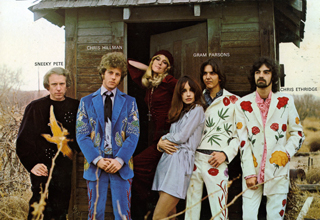Human Flower Project
Tuesday, December 04, 2007
The Suit That Alt-ed Country Music
Gram Parsons staged a collision of glam-rock, C&W, Southern gospel, and rhythm and blues that survives him, as alt-country music. A new biography shows how a glittering floral suit set him up for stardom in more ways than one.

Backside of “The Gilded Palace of Sin”
first LP of the Flying Burrito Brothers, 1969
Photo: Barry Feinstein
In our weekly browse through the record bin at Woolco one evening in 1969, we came upon a peculiar sight. A new LP pictured several long-haired guys (one of whom we recognized as Chris Hillman of the Byrds) standing out in the desert with vixen-models – nothing so strange about that. The flipped out part of it was they were dressed in glittery suits, like the stuff that country singer Buck Owens wore on television. Sure, the Beatles had put on day-glo band uniforms for Sergeant Pepper, but this was different. What were a bunch of hip musicians doing twinkling like Liberace? On second take, we noticed that the suit of one dude – the handsome one—had been decorated with sequined marijuana leaves.
 Gram Parsons (with friend) in the destiny suit
Gram Parsons (with friend) in the destiny suit
made to order by Nudie Cohn
Photo: Barry Feinstein
We went home with “The Gilded Palace of Sin,” fire and brimstone preached with a psychedelic pedal steel guitar. Our new favorite band was The Flying Burrito Brothers, led by Gram Parsons, a redneck Beau Brummel and human train wreck. Nearly forty years later, our friend David Meyer has written a whopper biography of Parsons and the alt-country music scene Gram, in a stupor, managed to create. What makes it a Human Flower Project is this suit, now enshrined in the Country Music Museum in Nashville.
It was made by Nudie Cohn – the same tailor who dressed up Roy Rogers and the country and western singing stars. Though this was several decades before celebrity “branding,” all Nudie’s sequined ensembles were indelible. For Porter Wagner, there were glittering wagon wheels, prison bars for Webb Pierce. And for Gram Parsons, the poor little rich Southern preppie hippie addict, there would be appliqué Seconals and sequined poppies.
In 1969, the Nudie suit looked like a devilish joke on all those rubes who wouldn’t know cannabis from cactus, an opium poppy from the San Antone rose. But when Parsons died of a morphine overdose in a motel room at Joshua Tree, age 26, the suit with sequined poppies began to look eerie – like a smuggled plea.
We think David’s book Twenty Thousand Roads is a masterful piece of work, orchestrating scores of interviews and piecing back together another time and its psyche. Way back then, to sing an anti-war song with a twang and invoke Buck Owens with pot on your breath were acts of trespassing. Among all Gram’s sins, time has forgiven—even gilded— these.




